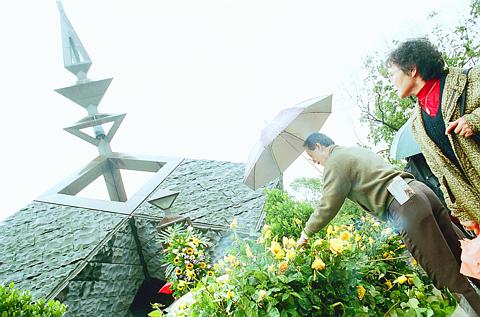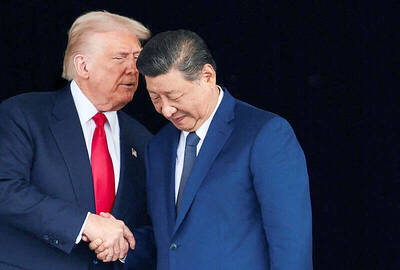Relatives of victims of the 228 Incident and social critics yesterday panned the government for not doing enough to reveal the truth about the tragic events of 1947.
Thousands of people yesterday flocked to Taipei's 228 Memorial Park to attend a series of activities held to commemorate the brutal suppression of civil unrest in 1947 which left up to 30,000 dead.
Commemorative events included an art exhibition at the museum with works collected from relatives of the victims of the massacre, the chanting of Buddhist sutras and paper lily folding.

PHOTO: GEORGE TSORNG, TAIPEI TIMES
But while events in remembrance of the massacre have grown rapidly in number in recent years, along with Feb. 28 being declared a national holiday by the government, for some, commemoration is not enough. They want more facts.
"Fifty years after my father died, I still don't know when or how he was killed. The mystery of his death has left a painful scar in my heart," said Juan Mei-shu (
"During the past decades, I have sought comfort in music and art. But my greatest hope is that one day evidence will be gathered to explain my father's death," she said.
Juan said her father Juan Chao-jih (
Juan's father was just one of the estimated tens of thousands of Taiwanese civilians killed in a massive military crackdown that followed islandwide protests against the KMT's corrupt administration of the island following the transfer of control from Japan at the end of WWII.
Taiwanese disgust with the lawless rapacity of the administration of Chen Yi (
Lin was left bloody and unconscious on the ground. An angry crowd gathered and turned on the agents, who fired their guns wildly to escape, killing a man named Chen Wen-hsi (陳文溪). When monopoly agents were discovered pistol-whipping two children for a similar offense the following day, an angry crowd beat the agents to death. The incident then sparked island-wide anti-KMT protests and riots.
KMT troops were rushed from China in early March to quell the disturbances and tens of thousands of Taiwanese were killed.
For years, talk of the incident was taboo while Taiwan was under martial law from 1949 to 1987.
Starting from 1987, Taiwanese intellectuals such as Cheng Nan-jung (鄭南榕) and Chen Jung-hsing (陳永興) initiated the 228 Public Benefit Peace Movement to call for uncovering the truth of the 1947 events. But it was not until 1993 that the first official report -- "A Research Report on the 228 Incident" (二二八事件研究報告) -- was issued. It is estimated that up to 28,000 people were killed in the tragedy.
And it was not until 1995 that President Lee Teng-hui (
On the 53rd anniversary of the tragedy yesterday, people around the island chose different ways to commemorate the traumas of the past.
Juan Mei-shu chose to display her art to remember her father and others who were killed, while hundreds of relatives of the victims gathered in front of the monument in the 228 Memorial Park to chant Buddhist sutras to remember their loved ones.
"For my generation, it's a history that is forbidden to be mentioned. But now I want my child to learn about the buried history, about what happened in post-war Taiwan," said Diana Wu (吳婉如), while joining an activity held in the museum to make paper lilies with her 10-year-old daughter Chen Shih-chi (陳詩琪).
Coming to the museum to learn about the long-suppressed history, however, 24-year-old graduate student Yu Sheng-jen (游生任) expressed his disappointment with information available at the museum.
"Archives and files here are mainly from private groups while the official documents are relatively scarce here. The government should do more to release related files," Yu said.
At the opening of the art exhibition, Taipei Mayor Ma Ying-jeou (馬英九) said the museum will continue its work documenting historic truths and helping facilitate Taiwan's ethnic harmony.
Speaking in front of the monument in the park, DPP presidential candidate Chen Shui-bian (陳水扁) vowed to set up a national-level memorial museum to help unravel the historical facts of the 228 Incident if he won in the March 18 presidential election.
Lee Min-yung (
"The government should release related files to allow researchers to find out who gave the order to start the killing, and who were the exact executors of the order.
"Then these files can help sociologists and historians work out the pathological factors that led up to the 228 Incident," he said.
"If we cannot face up to historical truth, everybody in Taiwan will remain a victim of that incident in one way or another," he said.

CALL FOR SUPPORT: President William Lai called on lawmakers across party lines to ensure the livelihood of Taiwanese and that national security is protected President William Lai (賴清德) yesterday called for bipartisan support for Taiwan’s investment in self-defense capabilities at the christening and launch of two coast guard vessels at CSBC Corp, Taiwan’s (台灣國際造船) shipyard in Kaohsiung. The Taipei (台北) is the fourth and final ship of the Chiayi-class offshore patrol vessels, and the Siraya (西拉雅) is the Coast Guard Administration’s (CGA) first-ever ocean patrol vessel, the government said. The Taipei is the fourth and final ship of the Chiayi-class offshore patrol vessels with a displacement of about 4,000 tonnes, Lai said. This ship class was ordered as a result of former president Tsai Ing-wen’s (蔡英文) 2018

‘SECRETS’: While saying China would not attack during his presidency, Donald Trump declined to say how Washington would respond if Beijing were to take military action US President Donald Trump said that China would not take military action against Taiwan while he is president, as the Chinese leaders “know the consequences.” Trump made the statement during an interview on CBS’ 60 Minutes program that aired on Sunday, a few days after his meeting with Chinese President Xi Jinping (習近平) in South Korea. “He [Xi] has openly said, and his people have openly said at meetings, ‘we would never do anything while President Trump is president,’ because they know the consequences,” Trump said in the interview. However, he repeatedly declined to say exactly how Washington would respond in

WARFARE: All sectors of society should recognize, unite, and collectively resist and condemn Beijing’s cross-border suppression, MAC Minister Chiu Chui-cheng said The number of Taiwanese detained because of legal affairs by Chinese authorities has tripled this year, as Beijing intensified its intimidation and division of Taiwanese by combining lawfare and cognitive warfare, the Mainland Affairs Council (MAC) said yesterday. MAC Minister Chiu Chui-cheng (邱垂正) made the statement in response to questions by Democratic Progressive Party (DPP) Legislator Puma Shen (沈柏洋) about the government’s response to counter Chinese public opinion warfare, lawfare and psychological warfare. Shen said he is also being investigated by China for promoting “Taiwanese independence.” He was referring to a report published on Tuesday last week by China’s state-run Xinhua news agency,

‘ADDITIONAL CONDITION’: Taiwan will work with like-minded countries to protect its right to participate in next year’s meeting, the foreign ministry said The US will “continue to press China for security arrangements and protocols that safeguard all participants when attending APEC meetings in China,” a US Department of State spokesperson said yesterday, after Beijing suggested that members must adhere to its “one China principle” to participate. “The United States insists on the full and equal participation of all APEC member economies — including Taiwan — consistent with APEC’s guidelines, rules and established practice, as affirmed by China in its offer to host in 2026,” the unnamed spokesperson said in response to media queries about China putting a “one China” principle condition on Taiwan’s